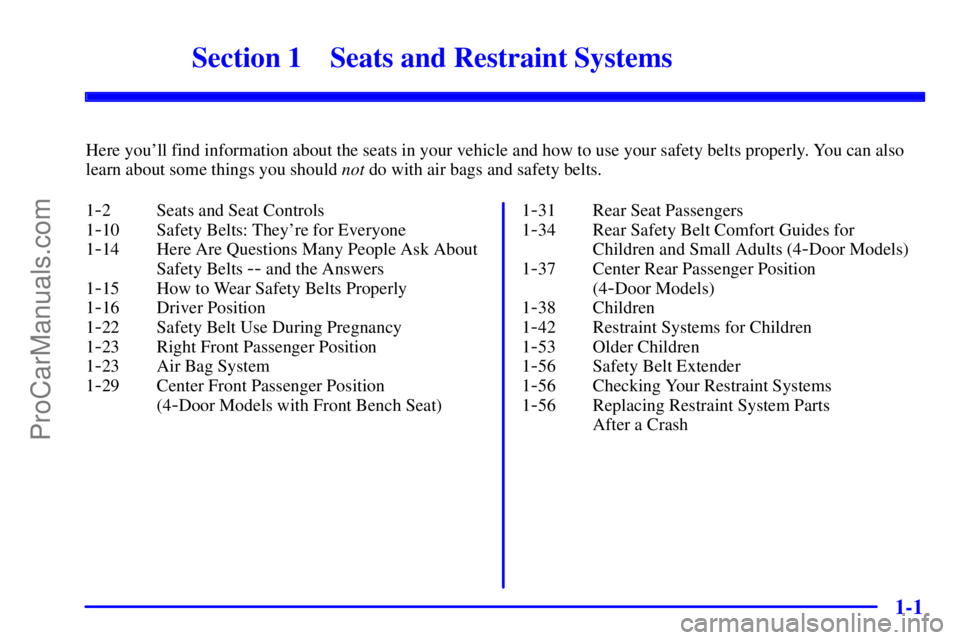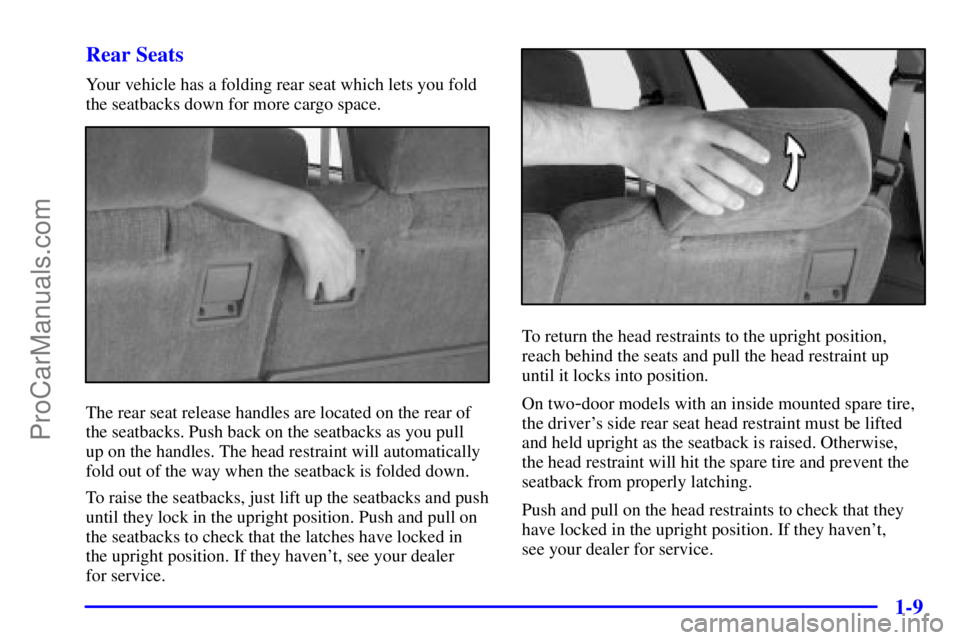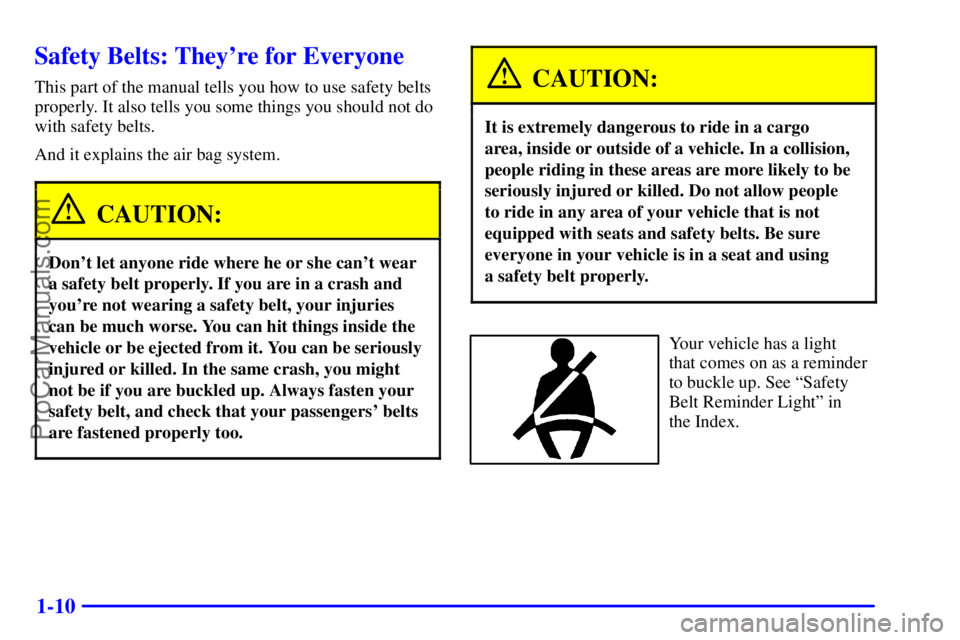Page 4 of 448
ii
Table of Contents
Windows
Keys and Door Locks
Remote Keyless Entry System (If Equipped)
Endgate/Liftgate
Automatic Transmission (If Equipped)
Manual Transmission (If Equipped)
Four-Wheel Drive (If Equipped)
Parking Brake
Tilt Wheel
Turn Signal/Multifunction Lever
Windshield WipersCruise Control
Exterior and Interior Lamps
Mirrors
Storage Compartments
Luggage Carrier (If Equipped)
Accessory Power Outlets
OnStar® System (If Equipped)
Sunroof (If Equipped)
HomeLink® Transmitter (If Equipped)
Instrument Panel, Warning Lights and Gages Seats and Seat Controls
Safety BeltsAir Bag Systems
Restraint Systems for Children
Section
1
Section
2
Seats and Restraint Systems
Features and Controls
ProCarManuals.com
Page 13 of 448

1-
1-1
Section 1 Seats and Restraint Systems
Here you'll find information about the seats in your vehicle and how to use your safety belts properly. You can also
learn about some things you should not do with air bags and safety belts.
1
-2 Seats and Seat Controls
1
-10 Safety Belts: They're for Everyone
1
-14 Here Are Questions Many People Ask About
Safety Belts
-- and the Answers
1
-15 How to Wear Safety Belts Properly
1
-16 Driver Position
1
-22 Safety Belt Use During Pregnancy
1
-23 Right Front Passenger Position
1
-23 Air Bag System
1
-29 Center Front Passenger Position
(4
-Door Models with Front Bench Seat)1
-31 Rear Seat Passengers
1
-34 Rear Safety Belt Comfort Guides for
Children and Small Adults (4
-Door Models)
1
-37 Center Rear Passenger Position
(4
-Door Models)
1
-38 Children
1
-42 Restraint Systems for Children
1
-53 Older Children
1
-56 Safety Belt Extender
1
-56 Checking Your Restraint Systems
1
-56 Replacing Restraint System Parts
After a Crash
ProCarManuals.com
Page 14 of 448
1-2
Seats and Seat Controls
This section tells you about the seats -- how to adjust
them, and fold them up and down.
Manual Front Seat
CAUTION:
You can lose control of the vehicle if you try to
adjust a manual driver's seat while the vehicle is
moving. The sudden movement could startle and
confuse you, or make you push a pedal when you
don't want to. Adjust the driver's seat only when
the vehicle is not moving.
Move the lever located under the front of the manual
seat up to unlock it. Slide the seat to where you want it.
Then release the lever and try to move the seat with your
body to make sure the seat is locked into place.
ProCarManuals.com
Page 15 of 448
1-3 Manual Lumbar Support (If Equipped)
If your vehicle has this
feature, there will be a knob
on the outboard side of the
driver's and passenger's
bucket seats.
Turn the knob counterclockwise to increase lumbar
support and clockwise to decrease lumbar support.
Power Seats (If Equipped)
If your vehicle has this feature, there will be a control on
the outboard side of your seat.
Horizontal Control: Raise or lower the front of the
seat by raising or lowering the forward edge of
the control.
Raise or lower the rear of the seat by raising or lowering
the rear edge of the control. Move the seat forward or
rearward by moving the whole control toward the
front or the rear of the vehicle.
ProCarManuals.com
Page 17 of 448

1-5
When your vehicle is in PARK (P) for an automatic
transmission or the parking brake is engaged for a
manual transmission, push and release the numbered
memory button you just stored. The seat will move to
the set position. You will hear one chime.
Pressing the UNLOCK button of a keyless entry
transmitter will adjust the seat to the corresponding
stored memory position. You will hear one chime.
Repeat Steps 1 and 2 to readjust the seat. The transmitter
need not be reprogrammed unless it needs to correspond
to the other numbered memory button.
To set the seat for a second driver, follow the previous
steps, but use the other numbered button and the other
keyless entry transmitter.
If there is a third driver, use the seat adjuster switch to
adjust the seat. Pressing any of the seat adjuster switches,
the SET button or pressing the desired memory button
twice will cause the seat to stop moving.
If you push the numbered button to adjust the seat
and start the vehicle while the seat is still adjusting,
adjustment will pause while the ignition is in START.
Adjustment will resume after the ignition is in RUN.Heated Front Seats (If Equipped)
If your vehicle has this
feature, the controls are
located on the outboard
side of the seats.
This feature will quickly heat the lower cushion and
lower back of the driver's and front passenger's seats
for added comfort.
Press the lower part of the switch to turn the heater on
low. Press the upper part of the switch to turn the heater
on high. Put the switch in the center position to turn the
heater off.
The passenger's safety belt must be engaged for the
heated seat feature to work on the passenger's seat.
ProCarManuals.com
Page 21 of 448

1-9 Rear Seats
Your vehicle has a folding rear seat which lets you fold
the seatbacks down for more cargo space.
The rear seat release handles are located on the rear of
the seatbacks. Push back on the seatbacks as you pull
up on the handles. The head restraint will automatically
fold out of the way when the seatback is folded down.
To raise the seatbacks, just lift up the seatbacks and push
until they lock in the upright position. Push and pull on
the seatbacks to check that the latches have locked in
the upright position. If they haven't, see your dealer
for service.
To return the head restraints to the upright position,
reach behind the seats and pull the head restraint up
until it locks into position.
On two
-door models with an inside mounted spare tire,
the driver's side rear seat head restraint must be lifted
and held upright as the seatback is raised. Otherwise,
the head restraint will hit the spare tire and prevent the
seatback from properly latching.
Push and pull on the head restraints to check that they
have locked in the upright position. If they haven't,
see your dealer for service.
ProCarManuals.com
Page 22 of 448

1-10
Safety Belts: They're for Everyone
This part of the manual tells you how to use safety belts
properly. It also tells you some things you should not do
with safety belts.
And it explains the air bag system.
CAUTION:
Don't let anyone ride where he or she can't wear
a safety belt properly. If you are in a crash and
you're not wearing a safety belt, your injuries
can be much worse. You can hit things inside the
vehicle or be ejected from it. You can be seriously
injured or killed. In the same crash, you might
not be if you are buckled up. Always fasten your
safety belt, and check that your passengers' belts
are fastened properly too.
CAUTION:
It is extremely dangerous to ride in a cargo
area, inside or outside of a vehicle. In a collision,
people riding in these areas are more likely to be
seriously injured or killed. Do not allow people
to ride in any area of your vehicle that is not
equipped with seats and safety belts. Be sure
everyone in your vehicle is in a seat and using
a safety belt properly.
Your vehicle has a light
that comes on as a reminder
to buckle up. See ªSafety
Belt Reminder Lightº in
the Index.
ProCarManuals.com
Page 28 of 448
1-16
Driver Position
This part describes the driver's restraint system.
Lap-Shoulder Belt
The driver has a lap-shoulder belt. Here's how to
wear it properly.
1. Close and lock the door.
2. Adjust the seat so you can sit up straight.
To see how, see ªSeatsº in the Index.
3. Pick up the latch plate and pull the belt across you.
Don't let it get twisted.
The shoulder belt may lock if you pull the belt across
you very quickly. If this happens, let the belt go back
slightly to unlock it. Then pull the belt across you
more slowly.
ProCarManuals.com